Tracing the glorious Egyptian Civilisation.
By B.S. Narayanaswamy
It all started with Great Napolean conquering Egypt in 1799 and made it a French Colony. His army could find a stone (now called Rosetta stone) with strange etchings of three languages at a place called Rashid, 15 kms from Alexandria. This paved the foundation for further excavation throughout Egypt which unfolded this great civilisation.
Alexandria, the port city at the banks of Mediterranean sea, is generally the first stop. It mesmerises the visitor with its long water-front stretching more than 25 kms and overlooking Mediterranean sea. Built by Alexander the Great, this historical city houses remnants of Light-House built by him, one of the old wonders of the world. Pompey’s pillar and Katakomb, located amidst the poor colonies of Alexandria, speaks of the Ptolemy Kingdoms who ruled from 332 BC to 30 AD. It also depicts that the Greeks and Romans took large leaflets from Pharaohs by adoring the Gods “Ra”, “Isis”, “Osiris” and “Horus” worshipped by Pharaohs. The unassuming Katacombs is nothing but mass-Mummified graveyard for humans and horses. There was also a largest library in the ancient world in Alexandria containing works by the greatest thinkers and writers of antiquity, including Homer, Plato, Socrates and many more. The Library of Alexandria is popularly believed to have been destroyed in a huge fire around 2,000 years ago and its voluminous works lost. Now, a new library is built in its memory. The Museum of Alexandria has the bust of Cleopatra, the last Queen of Egypt, Julius Caesar and others.
The next place is the Giza Pyramids near Cairo, six in number and three are main, built as tombs of Kings named Cheops, Chephren and Mykerinos from 3rd dynasty, who were father, son and grandson. The Pyramid of Cheops is known as Great Pyramid, one of the wonders of the world and about 139 ft. tall. The stones at the bottom line weighs 15 to 20 Tons each and there are about 23 lakh stones used which were quarried at Aswan about 900 kms South and brought by boats! Such huge masonry works and Trigonometrically accurate structure still baffles the mathematicians. The second Pyramid looks picturesque with The Great Sphinx and other structures and the third one is small. The second Pyramid looks taller as it is situated in a higher altitude. These Pyramids are built around 2500-2600 BC for the purpose of housing the remains of the deceased Pharaohs. The Light and Sound Show in the evening makes a spectacular experience. The edges of Great Pyramid now have lost the finesse and symmetry to some extent due to time factor and looting of the stones in the past.
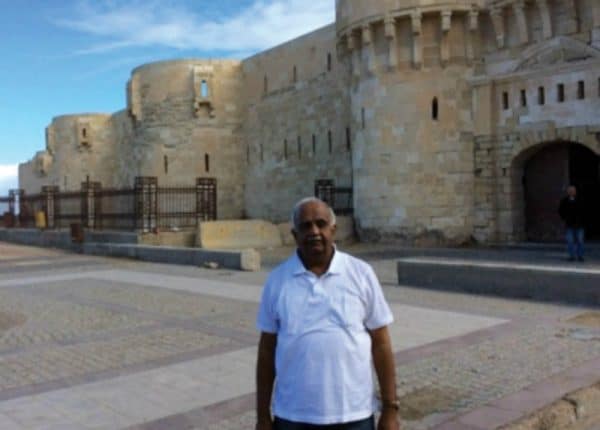
The author at the base of the Light-House built by Alexander the Great, one of the wonders of the world.
Cairo is the capital and largest city of Egypt. With Nile river passing in the middle of the city, it houses about 17 million inhabitants. The traffic is utter chaos and one can visualise what Bengaluru can become in 2022, given its present growth rate of vehicular population.
The Cairo Museum is perhaps the best Egyptian museum of antiquities and contains many important pieces of ancient Egyptian history, numbering about 1,20,000. It houses the world’s largest collection of Pharaonic antiquities. Two special rooms contain a number of Mummies of Kings and other royal family members of the New Kingdom. The Egypt tour is incomplete without visiting this great museum. A room is dedicated to King Tuth-ankh-amun, who is insignificant historically, and ruled for 9 years and died when he was nineteen years. In his tomb, apart from his Mummy, a gold mask of him weighing 11 kg, a golden cot and other artefacts weighing 110 kgs of gold, all encased in cuboid structures were found. Egyptologists increasingly believe that if tomb of an insignificant Pharaoh can have so much of wealth and artefacts, what it could have been with other successful Kings who ruled Egypt for nearly 2,500 years. It is believed to have been looted systematically over the years by tomb-looters and presently in private custody of individuals across the globe.
The Mummy room makes an interesting study. The Mummified body of Ramesses II still has hair, teeth and nails and so are other Mummies. Encased in glass boxes they seem to tell the life they led. Mummification in ancient Egypt was a well-developed process. They believed in “Life after death” and humans, animals and birds after their death were smeared with chemicals before filling the body with cotton or jute clothes. The major organs such as brain, lungs, and intestines were removed and kept in jars. A God by name “Anubis” was worshipped as Mummification God. Unfortunately, the art and process of Mummification is lost over the years.
The next place of visit is Abu Simbel Temple complex which fast forward the Egyptian History by about 1,200 years. After reaching Aswan by Air, a bus journey of 275 kms amidst Sahara desert and mirages takes you to this beautiful place. At the time of constructing high dam at Aswan for Nile river, the original temple was shifted to a nearby higher altitude place as it was to be drowned. The shifting of temple by German Engineers itself is a marvellous task involving shifting brick by brick and recreating the original temple as it was! Every visitor is sure to marvel at its size, magnificence and opulence. A historian is for a double treat as it depicts the civilisation during 1500 BC of Ramesses. The height of idols of Ramesses-II with three Gods is 65 ft. and the whole structure looks magnificent from a distance and the Nasser Lake in front of the temple leaves one with a bated breath.
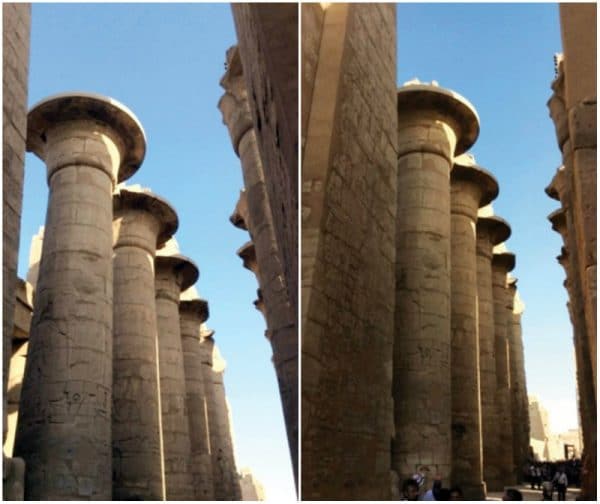
The huge pillars at Hypostyle Hall of Karnak Temple at Luxor.
The temple in a small island of Nile river called Philae known as “Osiris-Isis Temple” near Aswan is another beautiful temple built on Greek Architecture by Ptolemy Kings depicting the continuance of beliefs of Pharaohs by Greeks and Romans thereafter.
The Nile river cruise takes you to Kom Ombo, Edfu and Luxor temples which are magnificent temples. The Pharaohs believed in Sun God called “Ra” and all the temples were built on the East bank of Nile and tombs in the West bank.
Luxor city is on the East bank of the Nile river in Southern Egypt. It is on the site of ancient Thebes, the Pharaohs’ capital at the height of their power, during the 16th-11th centuries BC. Today’s city surrounds two huge, surviving ancient monuments — graceful Luxor Temple and Karnak Temple. Luxor Temple situated at the heart of the city on the Eastern bank of Nile river is one of the finest temples with excellent obelisk, great pillars and giant sized idols of Ramesses.
The valley of the Kings situated near the temple of Hathshupsuth houses three magnificent tombs of the Kings — Ramesses–IX, Merneptah and Tuth-Aank-Amun. The wealth and artefacts of Tuth-Aank-Amun were found here. It is believed that major wealth and artefacts in the valley has been looted by tomb-robbers and what is recovered is meagre compared to stolen wealth. The valley of the Queens contains tomb of Titi wife of Ramesses-II.
The hot balloon ride for an hour at Luxor takes you to various sites where the archaeological excavations are under progress. While writing this article, there was a newspaper item about idols of Pharaohs found in the mud-land at Cairo slum area. The future archaeological expeditions may bring to fore the life of the ordinary citizens of this civilisation of which little information is available as of now.
[The author is a Freelance Consultant (Valuation) and a retired Executive of Syndicate Bank, residing in Bengaluru. He can be contacted on Mob: 81052-29392]
[Concluded]



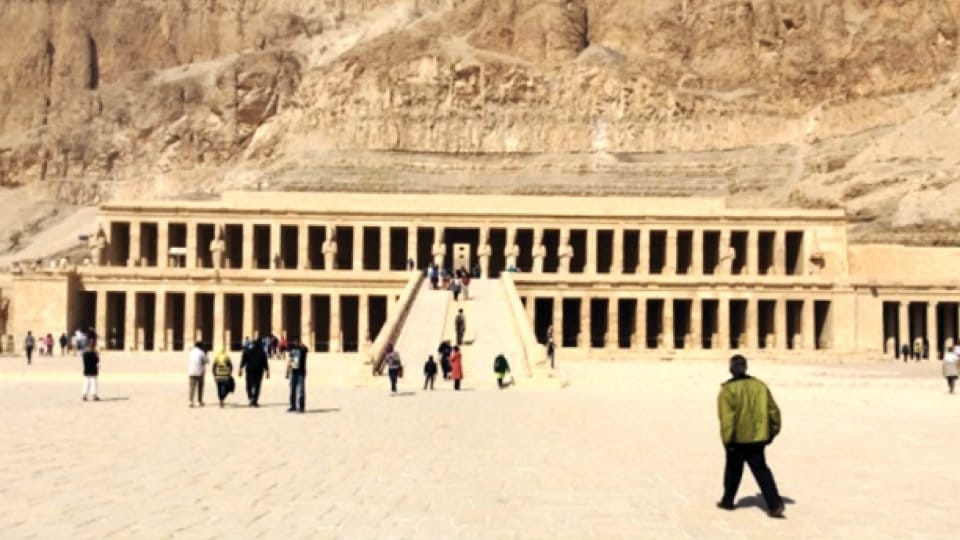
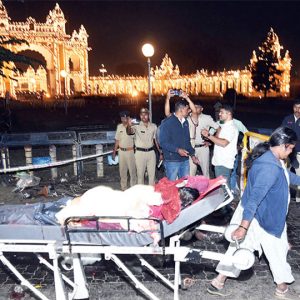

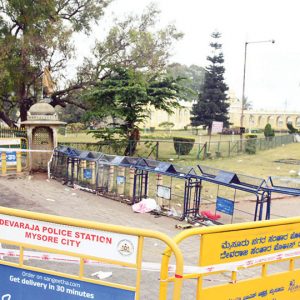

Recent Comments